30 Stunning Succulent Ground Cover Plants You Need to See
Looking to beautify your landscaping without breaking a sweat? Look no further than the marvelous world of succulent ground cover plants! These little wonders are like nature’s carpet, effortlessly transforming dull spaces into lush havens. And the best part? They’re not just pretty faces – they’re tough cookies too! With a bit of TLC and the right conditions, these hardy plants will thrive and make your gardening life a breeze. So, grab your gardening gloves and get ready to explore 30 stunning succulent ground cover plants that will take your next landscaping venture from drab to fab! Get ready to be inspired by nature’s green magic!
Contents
- 1 Aptenia cordifolia
- 2 Malephora crocea
- 3 Sedum rubrotinctum
- 4 Sedum pachyphyllum
- 5 Sedum lucidum
- 6 Conophytum novicium
- 7 Sedum stahlii
- 8 Faucaria lupina
- 9 Conophytum globosum
- 10 Crassula cv. Bride’s Bouquet
- 11 Faucaria longifolia
- 12 Portulaca lutea
- 13 Portulaca pilosa
- 14 Senecio herreianus
- 15 Portulaca amilis
- 16 Conophytum flavum subs. Novicium
- 17 Portulaca grandiflora
- 18 Senecio vitalis
- 19 Anacampseros rufescens
- 20 Sedum decumbens
- 21 Anacampseros filamentosa
- 22 Anacampseros tomentosa
- 23 Delosperma sphalmanthoides
- 24 Faucaria tigrina
- 25 Lithops vanzylii
- 26 Crassothonna capensis
- 27 Delosperma sawdahense
- 28 Crassula cv. Baby Necklace
- 29 Derenbergia biloba
- 30 Mesembryanthemum nodiflorum
Aptenia cordifolia

Rockrose or Noon flower – This succulent beauty hails all the way from South Africa, but it’s also traveled to other parts of the world. Its heart-shaped leaves gleam with a glossy green sheen, and it loves to surprise us with small, vibrant pink flowers. Aptenia cordifolia is the ground-covering succulent your landscaping dreams have been waiting for!
Malephora crocea
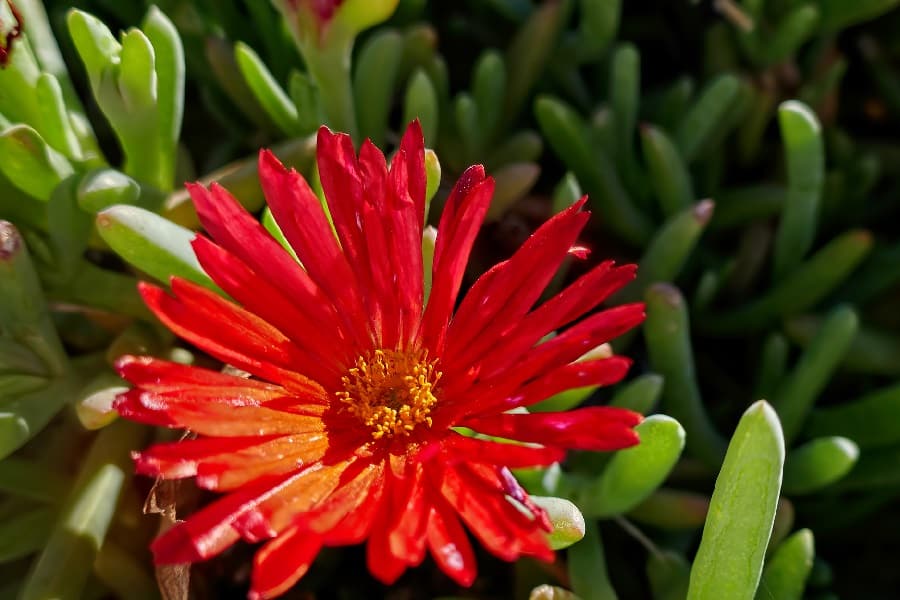
The Karoo Desert holds a special gem called Malephora crocea. This low-growing succulent is a native of Namibia and South Africa, but it has a knack for adapting to warmer climates in Spain, Mexico, and even parts of the United States. Its cheery orange flowers, reminiscent of daisies, bring joy to any space. This flowering succulent ground cover can be a stunning addition to your front yard, creating a colorful carpet of vibrant blooms that will catch the eye of every passerby.
Sedum rubrotinctum

Get ready for a succulent sensation with Sedum rubrotinctum! This Mexican marvel is a delightful blend of Sedum pachyphyllum and Sedum stahlii. With leaves shaped like jelly beans, this plant is a real treat. When exposed to sunlight, its leaves turn a vibrant red. And let’s not forget the bright yellow flowers that add a pop of color to its spiral clusters.
Sedum pachyphyllum
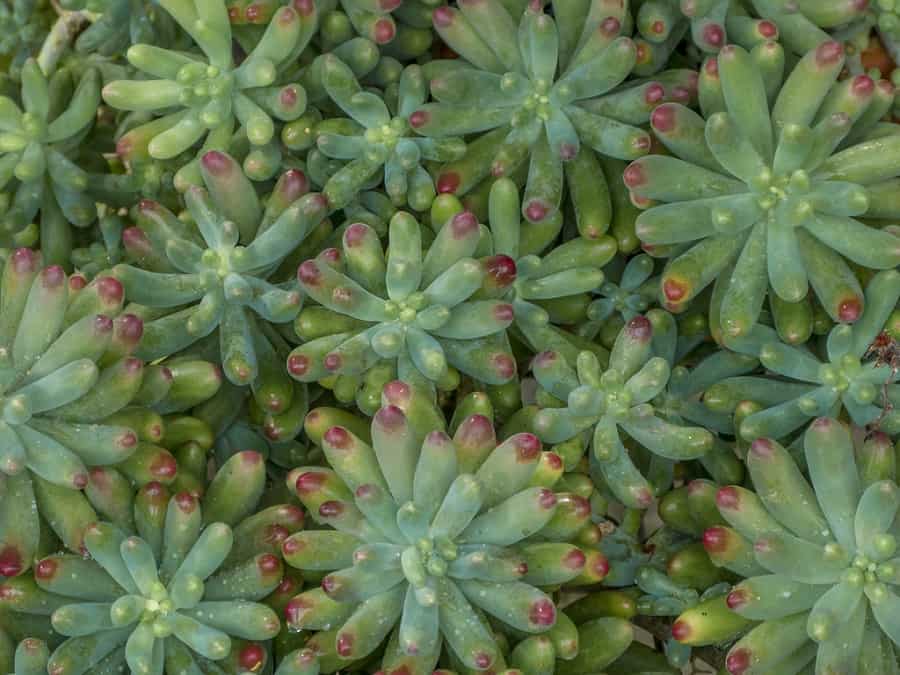
Another member of the “jelly bean” crew, Sedum pachyphyllum boasts green leaves covered in a shimmering silver film. Standing at about 12 inches tall, its upright stems curve elegantly towards the sky. With small, sunny yellow petals, its flowers make a radiant appearance during the summer months.
Sedum lucidum
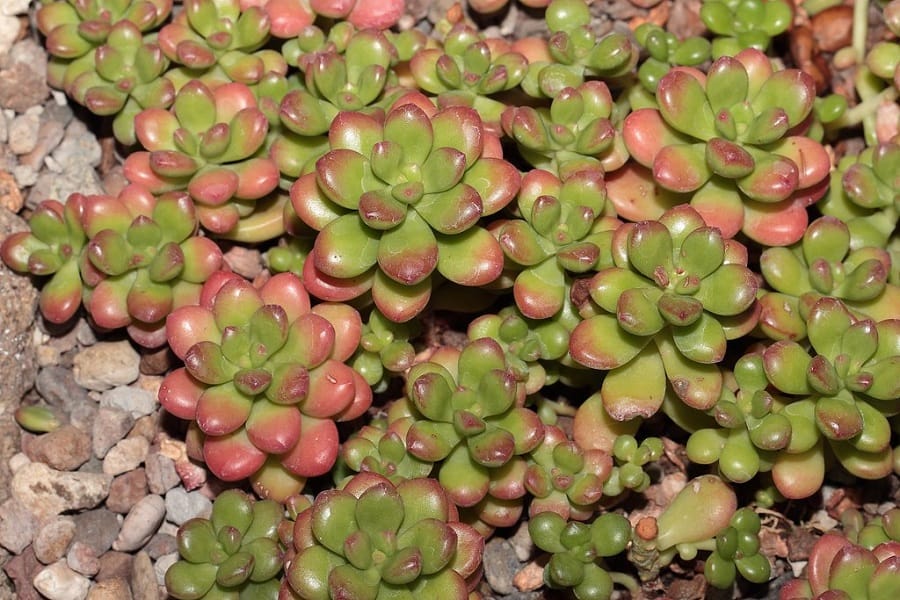
From Mexico and North America comes Sedum lucidum, a perennial succulent shrub that’s a true showstopper. Its thick green rosettes glisten in the sun, and when placed in bright light, they turn a mesmerizing shade of red. Perfect for creating vibrant shrubbery, this ground-covering beauty is a must-have in any garden.
Conophytum novicium

Don’t confuse this little treasure with its look-alike, Conophytum minutum var. Pearsonii. Conophytum novicium, found in South Africa’s Northern Cape, stands out when its striking golden yellow flowers bloom. Shaped like bells with slender petals, they create a breathtaking display.
Read also:
143 Types of Conophytum Succulents (With Pictures)
Sedum stahlii

Imagine a succulent that thrives on steep slopes of rock, and you’ve got Sedum stahlii. Native to Mexico’s Sierra Madre del Sur, this succulent sparkles with egg-shaped leaves and bright yellow star-shaped flowers. It’s no wonder it sometimes goes by the name “coral bells” – it’s a small wonder that adds a touch of magic to any garden.
Faucaria lupina

Venture to South Africa’s Eastern Cape Province, and you’ll discover the enchanting Faucaria lupina. Known as Wolf’s Jaws, this succulent has long triangular leaves that can resemble the ferocious bite of a wild wolf. Its silvery light green color adds a touch of serenity, while its bright yellow flowers bloom only when the sunlight is at its fullest.
Conophytum globosum

If you’re looking for a compact succulent that covers the ground like a boss, Conophytum globosum is the one for you. With its globose, kidney-shaped body and almost smooth surface, this little beauty is stemless or has incredibly short stems. When autumn arrives, its light pink or white flowers emerge, creating a delightful show.
Crassula cv. Bride’s Bouquet

Crassula cv. Bride’s Bouquet gets its name for a reason – its succulent flowers are like a special bouquet for a bride. This slow-growing plant stands at a height of 6-12 inches and adds elegance to any garden. Whether used as ground cover or dangling from hanging baskets, it brings a touch of romance to your space.
Faucaria longifolia

Prepare to be captivated by Faucaria longifolia, a South African succulent with silvery green triangle-shaped leaves bordered by spokes. Its leaves might remind you of the fierce jaws of an animal. In late autumn or winter, its daisy-like flowers burst forth, proving that it’s a tough plant that can withstand the occasional frosty spell.
Portulaca lutea

Indulge in the beauty of Portulaca lutea, an indigenous Hawaiian succulent that adorns the main islands (except Kaua’i). This beach-loving plant is no stranger to the sea, as fragments floating in the water help it propagate and handle the salty environment. Coral, sand dunes – you name it, this succulent can grow there, boasting its bright yellow flowers.
Portulaca pilosa

This pan-tropical shrub, Portulaca pilosa, is a flowering succulent that calls the Americas its home. From the Caribbean to the Indian subcontinent, you’ll find this beauty growing effortlessly. With its preference for sandy or gravelly soil and a penchant for staying out of direct sunlight, it’s commonly seen thriving on roadsides, especially on limestone, sandstone, and granite.
Senecio herreianus
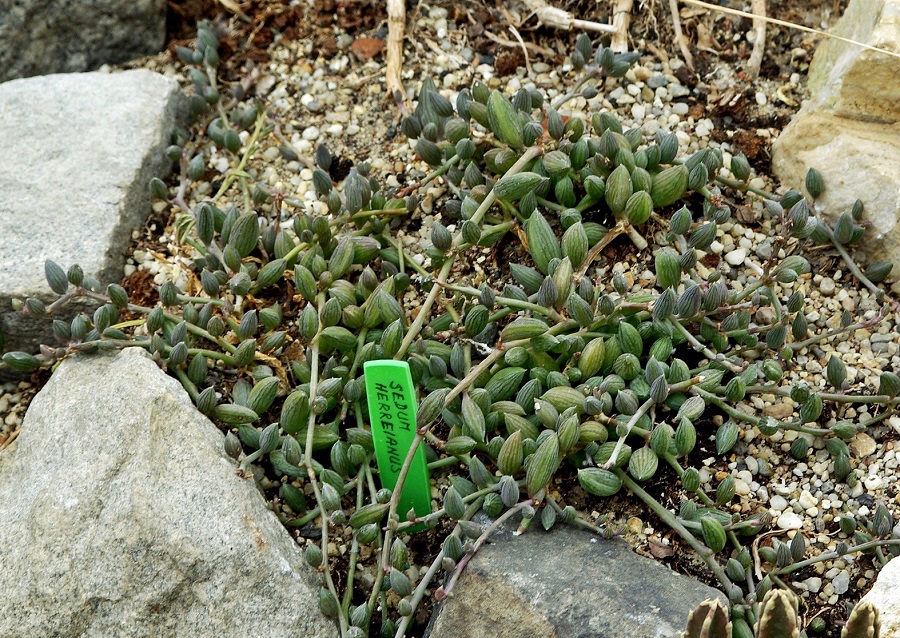
Set your sights on Southwest Namibia and northwest South Africa to discover Senecio herreianus, also known as ‘string of watermelon’ or ‘green marble vine’. As a lovely hanging plant, its spindle-shaped leaves are individually placed along the stem, resembling a chain of beads. They gracefully adorn the soil, adding a touch of elegance to your space.
Portulaca amilis

Journey to South America, and you’ll encounter Portulaca amilis, also called Puerto Rican Hot Pink succulent. Its neon pink flowers instantly bring vibrancy to any garden, and as a summer herb, it blooms annually. Growing up to 6-8 inches in height, this succulent boasts wiry branches and thick, fleshy leaves. If you’re looking to add a touch of romance to your garden, consider planting this succulent ground cover with pink flowers.
Conophytum flavum subs. Novicium
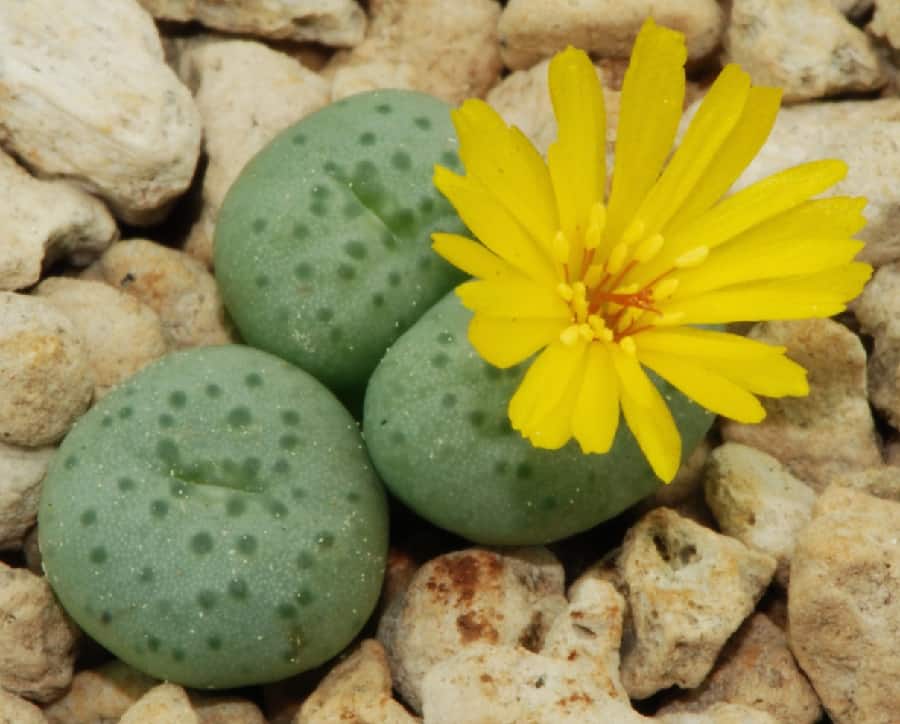
Hailing from the Northern Cape of South Africa, Conophytum flavum subs. Novicium thrives on granite or quartz outcrops. Its silver-green to dark green leaves have a glossy appearance, and the small golden yellow flowers bloom in the morning, adding a sunny touch to your garden.
Portulaca grandiflora

Uruguay, Brazil, and Argentina are the birthplaces of Portulaca grandiflora. Found in sandy soils, this succulent easily finds a home in gardens, offering splendid ground cover. Known as Eleven O’Clock plants, Moss-rose, or Moss-rose purslane, they add a burst of color to any space.
Senecio vitalis

From the Eastern Cape of South Africa, stretching from Alexandria to East London, comes Senecio vitalis. Basking in the summer sun, these succulents flourish in coastal areas, where moisture is readily available. Embrace their love for the coast, and they’ll reward you with lush growth.
Anacampseros rufescens

Clusters of Anacampseros rufescens grace the Cape Province of South Africa, reaching just a few inches in height. Their purplish-tinted leaves add a touch of allure, much like their delicate flowers. Blooming both singly and in small clumps, these flowers emit a gentle fragrance, adding to their charm.
Sedum decumbens

Sedum decumbens is a ground cover superstar, thanks to its flat, rounded leaves. The glossy green color shines bright, but come wintertime, a hint of red may appear. When spring arrives, multiple clusters of golden yellow flowers fill the air with a delightful fragrance.
Anacampseros filamentosa

As you venture to the northern regions of Namibia along the Orange River, prepare to be dazzled by Anacampseros filamentosa. Often known as Rabbit’s Foot, this succulent blooms in the summer, gracing the world with its lovely pink flowers. Thin strands of hair adorn its leaves, adding to its distinct beauty.
Anacampseros tomentosa

Another resident of northern Namibia, Anacampseros tomentosa finds its home among quartz and rocky slopes. Its unique seed type sets it apart from its previously mentioned cousin. Delicate cobweb-like hairs grace its leaves, adding a touch of whimsy to this captivating succulent.
Delosperma sphalmanthoides
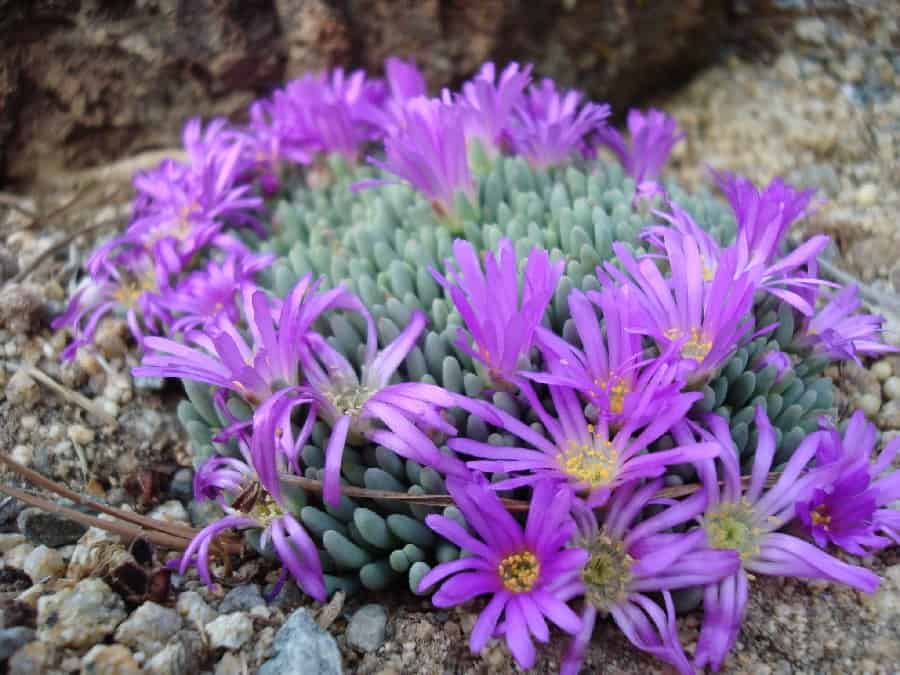
Reach for the sky, and you might just find Delosperma sphalmanthoides. Originating from South Africa’s high altitudes, this Tufted Ice Plant loves moisture year-round but takes it easy during the summer months. Its tiny blue-green leaves resemble delicate fingers, while its fuchsia-colored flowers paint a mesmerizing picture.
Faucaria tigrina

Think Cape Province, South Africa, and you’ll find the narrow succulent Faucaria tigrina. Once plentiful around Grahamstown, it’s now a rare species due to urban expansion. Its reddish leaves, decorated with tiny white flecks, effortlessly blend with red rocks in its surroundings, adding to its camouflage.
Lithops vanzylii

Cape Province, South Africa, holds a true gem – Lithops vanzylii. Flourishing in fine sand and arid regions, this plant expertly disguises itself among the stones and pebbles, earning the name Living Stone or Green Stone Plant. Its presence brings a touch of nature’s mystery to your space.
Crassothonna capensis

Meet Crassothonna capensis, a native of South Africa’s Little Karoo, which has also found a home in Tunisia and Algeria. Thriving in dry, rocky flats, its slender cylindrical leaves don a gray-green hue. And when bright light breaks through, its adorable daisy-shaped flowers unfurl, inviting you to appreciate their beauty from spring to autumn.
Delosperma sawdahense

Straight from Jabal Sawda in Saudi Arabia comes Delosperma sawdahense. This striking succulent unveils its plump leaves adorned with ice-like crystals all summer long. Its rosette-covered branches make a statement, and the best part is, this hardy plant requires little maintenance while growing at an impressive pace.
Crassula cv. Baby Necklace

Crassula cv. Baby Necklace, a hybrid of Crassula perforata and Crassula rupestris, knows how to turn heads. Its rounded, grayish-green leaves with a touch of red along the edges create a necklace-like appearance. Give this succulent a spot in your garden, and it will certainly steal the show.
Derenbergia biloba

In the western reaches of South Africa, you’ll discover Derenbergia biloba. With a preference for well-drained soil, a bit of moisture, and a touch of winter sun, this succulent steals the spotlight. Its triangular leaves showcase green margins, while the center displays a deep purple or red hue.
Mesembryanthemum nodiflorum

Native to southern Africa and Namibia, Mesembryanthemum nodiflorum has made its mark across the world. Found in regions with winter rainfall, you might catch a glimpse of it along roadsides. This succulent knows how to make itself at home, whether on coral or sand dunes, adding a touch of beauty wherever it grows.
Read also:
82 Types of Mesembryanthemum Succulents (With Pictures)
